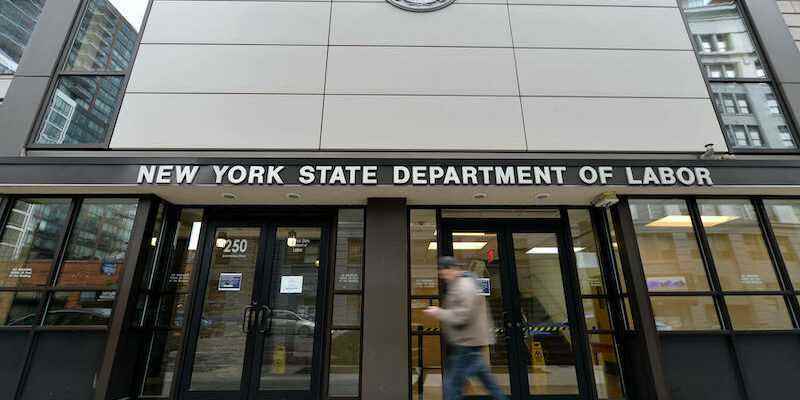The Paris Stock Exchange ended Friday’s session down, after the publication of employment figures in the United States far too good to convince the Fed to slow down in its march of raising interest rates. 390,000 jobs were created last month in the world’s largest economy, in the non-agricultural sector, according to official figures published by the Labor Department, more than expected by economists (the Bloomberg consensus forecast 320,000 hires, after 436,000 in April, revised from 428,000).
“The larger than expected increase […] indicates that the economy remains strong, while wage growth is beginning to moderate, in a context of a rebound in the active population. However, as wage growth remains well above rates consistent with the Fed’s 2% inflation target, this will not prevent the Fed from continuing to raise rates by 50 basis points in the next or of the next two meetings”comments Michael Pearce, US economist at Capital Economics. “Employment strength in May was broad-based, with solid gains in professional and business services (+75,000), leisure and hospitality (+84,000), construction (+36,000) and construction. manufacturing (+18,000). The only weak spot was retail trade, where employment fell by 61,000. These destructions were concentrated in general stores, reflecting the recent difficulties of Walmart and Target. »
the Bedroom 40 ends down 0.23% to 6,485.30 points, in very low trading volumes (2.16 billion euros, while British investors were still on leave for the Queen’s Jubilee). On Wall Street, the S&P 500 lost almost 2% and the Nasdaq Composite of technology stocks almost 3%.
“Good news is bad news”
Just yesterday, some investors were hoping that inflation would regulate itself, without the Fed needing to go too far in rate hikes, especially after the release of more data from the jobs, unofficial, excluding the public sector, showing a clear slowdown in creations. According to the monthly ADP survey, private companies created 128,000 jobs in May, almost half as much as in April. Data which then confirmed a certain cold snap on the job market in the United States as reflected by high-frequency data, such as the number of vacancies published on Indeed.com, stable again since beginning of the year. Some investors saw this as an indication to take to take positions on risky assets again. For them, the recent rebound of the stock market was not ultimately – at least until today – a simple burst in a bear market.
Announcements of job cuts at You’re here (-9%), because Elon Musk has “a very bad feeling about the economy”, had added more water to their mill this morning. But, after the publication of better than expected official figures, the reaction of the Stock Exchange only confirms that the narrative “Good news is bad news” (the good news is bad news) is making a comeback, as before the financial crisis. , when the bad indicators were a guarantee of support by the central banks. Today, because of inflation, the period of monetary easing, cheap money, liquidity injections is over. It’s time to tighten up. The balance sheet reduction by the US Federal Reserve even began this week.
Fed officials continued yesterday to push back against arguments for a pause in interest rate hikes. Vice-Chair Lael Brainard said a 50 basis point hike in June and July seemed reasonable. She added that it would be difficult to justify a pause in rate hikes in September. At a pinch, if inflation really slowed, the Fed could return to hikes of 25 basis points. Cleveland Regional Branch President Loretta Mester spoke even more aggressively than Lael Brainard, saying the pace of rate hikes could be accelerated if inflation results warrant it, and rates should probably exceed the neutral level, estimated around 2.5%. The key rate, that of the Fed Funds, is now moving within a range of 0.75 to 1%, after an increase of 25 basis points in March and one of 50 basis points in May.
Oil prices are on the rise again
In a context where inflation is the stock market’s main concern, the rise in the price of a barrel towards 120 dollars a barrel for Brent also weighed on the equity markets today.
OPEC+ met yesterday to decide on production quotas for July and August. The organization has agreed to accelerate the increase in its production, by 50% compared to the current rate, to reach 648,000 barrels per day, against 432,000 currently. 216,000 barrels more than initially expected are expected on the market this summer. But this is only theory since this new increase in production is distributed among OPEC members. This includes countries like Libya or Nigeria, which have already missed their previous production targets due to capacity constraints.
In fact, specialists at Citi have calculated that there would be only 132,000 barrels more than now on the market. “Currently, the market is in deficit of 750 kb/d. This increase therefore remains insufficient to balance the market., we add within the private bank Oddo BHF, where we explain that it is the improvement of relations between the United States and Saudi Arabia which is at the origin of this decision of OPEC + to pump more. The Stock Exchange hopes that the announced visit of Joe Biden to the country will pave the way for further increases in production.
